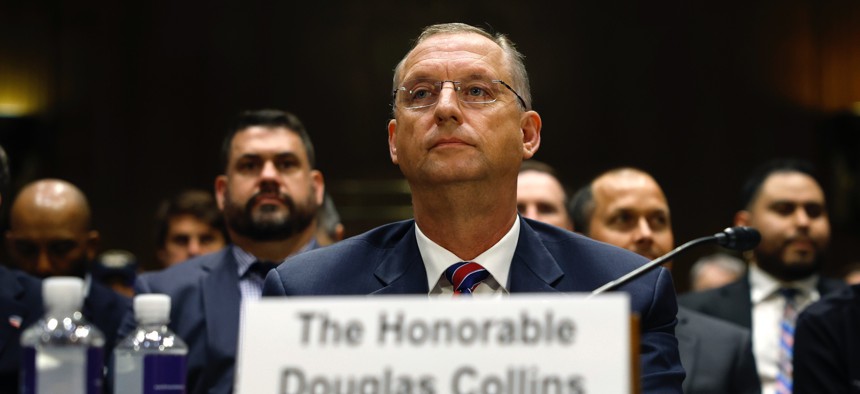
Veterans Affairs Secretary Doug Collins testifies before the Senate Veterans Affairs Committee on May 6, 2025, in a hearing to examine the future of the department. Kevin Dietsch / Getty Images
Lawmakers raise bipartisan concerns over VA RIFs as secretary says he may alter plans
VA secretary says he could end up cutting fewer than the proposed 80,000 employees, but the final tally could be greater as well.
The Veterans Affairs Department is still planning to shed around 80,000 employees from its rolls by the end of the fiscal year, its chief told lawmakers on Tuesday, but suggested he could waver from those projections as members of both parties expressed reservations about the cuts.
Secretary Doug Collins frequently voiced frustration with lawmakers who questioned his vision to slash the VA workforce to fiscal 2019 levels, or a cut of about 15%, saying the target was a “predecisional” goal and subject to change. He expressed anger the figure became public—which occurred only after Government Executive reported on an internal memorandum that detailed it—despite repeatedly confirming the goal, saying it was being used to scare veterans and his employees.
“A goal is not a fact,” Collins said of the projected cuts. “You start with a goal. You start with what you look for, and then you use the data that you find from your organizations to make the best choices you can.”
He added his adjustments could lead to even more significant reductions.
“It could be less, could be more,” Collins said. “It is a goal that you have to look at. You have to start somewhere.”
Collins’ comments followed Sen. Jerry Moran, R-Kan., who chaired Tuesday’s Senate Veterans’ Affairs Committee hearing, suggesting the leaked memo “caused understandable concerns.”
“It ought not be a set number that you’re trying to reach,” Moran said. “It ought to be about rightsizing the department of Veteran Affairs."
The chairman called on Collins to work closely with the committee, veterans, VA staff and veterans service organizations in crafting a workforce plan that is “backed by data, informed by veteran demand [and] focused on improving outcomes for the men and women that VA serves.” He added that VA should maintain a quality and accountable workforce and any layoffs should ensure employees are treated “with gratitude and respect.”
Sen Richard Blumenthal, D-Conn., the top Democrat on the committee, said he was open to some reforms at VA but disapproved of Collins’ approach.
“Improvement is absolutely necessary but it shouldn’t be done with a chainsaw,” Blumenthal said. “We need to avoid the potential disaster that is looming. Make no mistake, it is a disaster that is on the horizon.”
Collins said no front-line doctors, nurses or benefits administrators would be cut as part of the reductions. He suggested only roles such as interior designers in VA hospitals would be impacted, but lawmakers quickly noted the breadth of the secretary’s proposed layoffs could not be achieved without impacting critical support roles throughout VA’s health care system.
Sen. Maggie Hassan, D-N.H., joined several senators in criticizing Collins for “tossing out big numbers and cutting” before taking time to analyze the impacts of the changes. When Collins responded defensively to questions about the proposal, Hassan said he was shielding himself from oversight.
“The VA cannot have it both ways,” the senator said. “They cannot set out a goal and then get angry at us for asking what the impacts of that goal and those cuts would be.”
VA staffed up significantly under the Biden administration, including a record-setting year in fiscal 2023 when the Veterans Health Administration alone hired 61,000 new employees. Both VHA and the Veterans Benefits Administration has been staffing up to accommodate the flood of veterans newly eligible for care and benefits under the PACT Act, though hiring slowed in fiscal 2024.
More than one million veterans have received disability compensation as a result of the 2022 law and more than 700,000 have enrolled in VA health care.
VA is currently developing its final workforce plan and has solicited feedback from executives throughout the department. In an unusual move, it has asked those employees to sign non-disclosure agreements related to the planning. VA supervisors have told employees that as a result, they cannot respond to questions to which they know the answers.
Collins repeatedly criticized lawmakers for putting forward figures before they were finalized, but said he could not provide any further clarity because it would be unfair to his workforce to engage in such discussions while the talks were still underway. The original plan called for a departmentwide review to be completed by May 9, but Collins said on Tuesday that timeline has been delayed as VA continues to gather more information.
Sen. Thom Tillis, R-N.C., said he could not give his opinion on the workforce reduction plan because he did not “have the details.” It was still unclear to him whether VA should cut 80,000, 8,000 or 800 employees, the senator said, but he would make a judgment on the plan once one is presented before him.
How are these changes affecting you? Share your experience with us:
Eric Katz: ekatz@govexec.com, Signal: erickatz.28
NEXT STORY: 19 states sue Trump administration over mass layoffs at HHS







